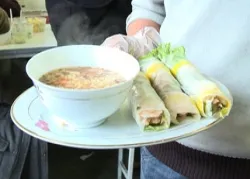Nem is a Vietnamese word for minced pork. It is the basis for such dishes as nem rán – fried nem (chả giò), nem cuốn – wrapped nem (gỏi cuốn) and nem chua (pickled nem).
Nem rán (sajgonki)
In the filling you can find minced meat, soy pasta, mushrooms (most often mun), grated carrot and other vegetables. All these ingredients are seasoned and wrapped in a soaked rice paper. They are deep-fried in oil, thanks to which they become crisp and golden in color.
Some people claim that they become more aromatic if rice paper is soaked in the mix of beer and water. Nem rán which are served in Poland differ from original ones mainly in size – they are over two times thicker and longer. Maybe this is caused by the difference in the appetites of Poles and Vietnamese or maybe it is a result of the differences in temperature. Temperature in Vietnam effectively discourages people from eating high-fat and hot dishes.
“Sajgonki” are not the favorite meal of the Vietnamese at all (most often the favorite meal is phở soup). They are usually served during the celebration of the Vietnamese New Year and during family parties. They must be accompanied by sauces. The plainest sauce is a thin fish sauce with a bit of sugar, lemon juice and a crushed clove of garlic.
Nem cuốn
Known also as spring rolls or summer rolls, gỏi cuốn are a fantastic alternative to greasy “sajgonki” which emit an intensive smell of burnt oil. Gỏi is a name for a dish that includes raw fish or vegetables. Gỏi cuốn (nem cuốn) is a light dish which you often make on your own in a bar or a restaurant.
You can make spring rolls from fresh vegetables and fruit cut into thin strips, aromatic herbs, cooked fish and seafood. If you add fried tofu and rice pasta, you will get a delicious filling for spring rolls. You should wrap your composition of flavors into rice paper that has been soaked in water and then dip it in sauce. This will satisfy your taste buds.
Nem chua
It is the most obscure member of the nem family. Its wide variety of flavor variants makes it stand out. In order to prepare nem chua you need a thinly minced pork and pork rind, spices and aromatic leaves (most often of a banana tree). Meat must be mixed well with vegetables and garlic and then shaped into cylinders of the size of a finger. You need to cover the mix with leaves, tie a string around it and leave it for 3-5 days so that it could ferment naturally.
Nem chua is a combination of sweet, sour, salty and hot flavors. Final composition of flavors depends on the recipe which has been used. Various regions in Vietnam are famous for their unique recipes.
The most renowned ones are e.g. nem from Thanh Hóa, Đồng Tháp or Ninh Hòa.
If you travel by train through the regions which are known for good recipes, at railway stations you will see salesmen handing their food through the windows of train cars and persistently encouraging passengers to try their local nem chua.
Unfortunately, it is difficult to find nem cuốn on the menus of Vietnamese restaurants. Finding nem chua is bordering on the miraculous – sometimes they are sold in Vietnamese grocery stores in the 10th-Anniversary Stadium (Stadion Dziesięciolecia). If you are unwilling to try your hand at cooking, you are condemned to “sajgonki” from a nearby bar.
The recipe for the most popular version of nem
Ingredients
- carrot, onion
- mun mushrooms
- soy pasta
- minced pork and beef
- spices: pepper, fish sauce
- eggs
- rice paper
- oil for deep-frying
The amount and proportions of the ingredients depend on your preferences for mainly meat or mainly vegetable spring rolls.
Chop up or grate carrot and onion. Soak soy pasta in warm water until it swells and becomes soft. Cut it into thin slices (about 1-2 cm long). If you have dried mun mushrooms, soak them too until they swell and then chop them up like carrot and onion.
Mix carrot, onion, mushrooms, pasta and meat in a big bowl or in a pot. Optionally, you can use a mixer in order to mix the ingredients thoroughly. Add spices: pepper, fish sauce (it is salty and it replaces salt so you need to be careful) and, optionally, hot pepper. Add eggs to the filling so that, after mixing, the consistency of the filling would resemble minced meat used for chops (it may be less solid).
Wrapping spring rolls
Prepare a soup plate with tepid water and soak a sheet of rice paper in it. Soak both sides of the paper until soft. The paper should not disintegrate or tear in your hands. You can use a new dish-washing sponge, wet it and then moisten the paper, which has been spread on a tray.
Put the paper on a board or a tray. Place the filling on the rice paper with your hand or a spoon (about one and a half of a heaped table spoon). Do not put the filling in the middle of the paper but close to the edge which is the closest to you. Make a roll from the filling leaving about 1-2 cm of space between the edge of the paper and the filling. Start wrapping the rice paper around the filling. When 1/3 of the paper is wrapped, bend the right and the left edge of the paper inside so that the filling would not escape through the sides. Then wrap the rest of the roll.
Frying
Deep-fry spring rolls until meat is fried and rolls turn brown. If you do not plan to serve them on the same day, you can fry them only a bit and finish frying on the next day – thanks to that spring rolls will not lose their crispiness. You can reheat spring rolls on the pan.
Sauce
The simplest sauce for spring rolls can be made by thinning a fish sauce with a bit of water and then adding some sugar, lemon juice and a crushed clove of garlic. For a spicy flavor you can add a chopped chili pepper.
Vegetarian spring rolls
In the filling of vegetarian spring rolls meat is replaced by tofu (it does not need to be cooked first because it will be fried together with the spring rolls). Another good idea is to use soy patties and prepare them analogously to minced meat.
Text by Đàm Vân Anh
Translated by Krystyna Szurmańska












